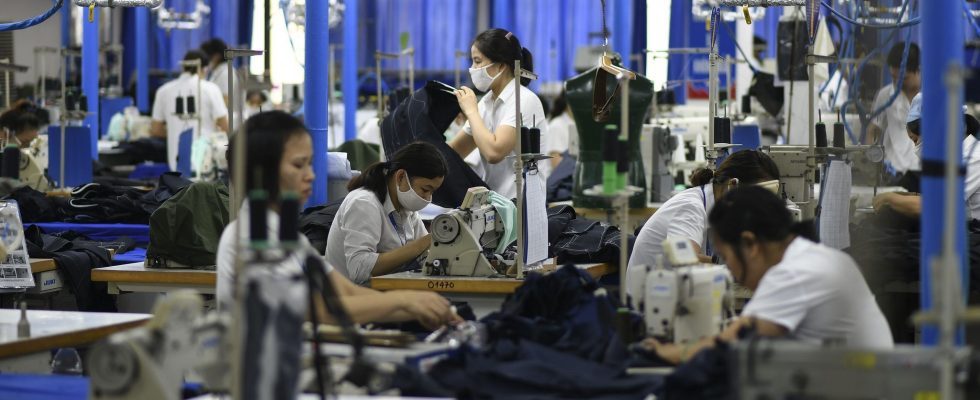This Haute-Savoie entrepreneur is convinced of this: he invests in the right place and at the right time. His company, which specializes in precision mechanics for automobiles and home automation, already has a sales office in China, in Shanghai. But it is 2,500 kilometers further south, near Ho Chi Minh City, the Vietnamese economic capital, that Lionel Baud has decided to build his first Asian factory, which should be operational in September. “In industry, there is the same enthusiasm for Vietnam today as for China twenty years ago: more and more of our customers and suppliers are transferring their factories there, it creates a real dynamic “, enthuses the boss of Baud Industries, which carries out a significant part of its activity on the Chinese market.
Since the start of the Sino-American trade war in 2018, under Donald Trump, a growing number of investors and entrepreneurs have seen Uncle Ho’s country as the new Asian El Dorado. Thanks to its geographical proximity to the Chinese giant, its political stability and its abundant and cheap labour, Vietnam offers a way out for industrial groups established in China who wish to circumvent American sanctions.
The “zero Covid” policy was a catalyst
If most companies do not give up their Chinese factories, they now favor other low-cost countries to set up their new projects. Vietnam, and its market of 100 million inhabitants, is taking full advantage of this trend. “The fact that there is a potential clientele, particularly in the automobile industry, is significant, specifies Lionel Baud. The goal is to develop our local outlets.”
Foreign direct investment jumped 13.5% in 2022, to $22 billion – compared to a 6.3% increase in China, to $180 billion, traditionally driven by a handful of large German groups. Vietnam is also forecasting more than 6% economic growth this year, possibly the best performance in the region, ahead of China.
In this effervescent context, the Taiwanese electronics champion and Apple supplier Foxconn, which has a gigantic site in Shenzhen, has announced several waves of investments in Vietnam since August 2022, for a total of 400 million dollars, in Bac Giang province, northeast of Hanoi. The Danish Lego is building a mega-factory north of Ho Chi Minh City. The investment, amounting to 1 billion dollars, will give the group its second production site in Asia, after its factory in the suburbs of Shanghai.
“The trend of foreign investment in Vietnam dates back to the end of the 2000s, specifies Thi Anh-Dao Tran, economist at the University of Rouen and specialist in Vietnam. But China’s “zero Covid” policy and the confinements in repetition were a real catalyst. The big industrial groups realized that they had to find an alternative.”
“The management of the pandemic in China did not reassure us, confirms Lionel Baud. We wanted to settle in Vietnam more than in its neighbor…” Especially since the reform of the do me in 1986, which marked the opening to the market economy, Vietnam multiplied the measures to attract foreign investors. The Communist Party in power has meshed its territory with industrial zones, with light taxation, and signed no less than 18 free trade treaties, including one with the European Union, in 2020. Result, a jump in exports to 14% EU the following year. “The Vietnamese economy is fundamentally export-oriented. The government seeks above all to secure access to its markets”, notes Jean-Jacques Bouflet, vice-president of the European Chamber of Commerce in Ho Chi Minh City.
Geopolitical tensions
But the success story also has limitations. Although the authorities are trying to move upmarket by attracting investments with higher added value, Vietnam remains an assembly country with unskilled labour. “Long-term economic development will depend on Vietnam’s ability to innovate,” notes Quyen Nguyen, founder of the Vietnamese Association of supply chain. This means investing in education and training more engineers.”
For the time being, public resources are lacking and large firms often have to train their own technicians. This is the case of Korean Samsung, which opened its training center to meet its needs, while half of the brand’s smartphones are produced northeast of Hanoi. “Above all, the development based on industrial zones intended for foreign capital is a real obstacle to the emergence of a local industrial fabric which could both play this role of training and help in the development of transport infrastructures on the whole territory,” adds economist Thi Anh Dao.
Nevertheless, while geopolitical tensions around Taiwan or the war in Ukraine, and political pressure are growing in China, Vietnam, despite its authoritarian power and stifling bureaucracy, is more reassuring. More than 400 French executives took part in the Asia Pacific Forum of Foreign Trade Advisors, at the beginning of March in Ho Chi Minh City. And, that same month, a delegation bringing together some 50 American companies, including Boeing, Coca Cola and Netflix, went to Hanoi in search of investment opportunities.
